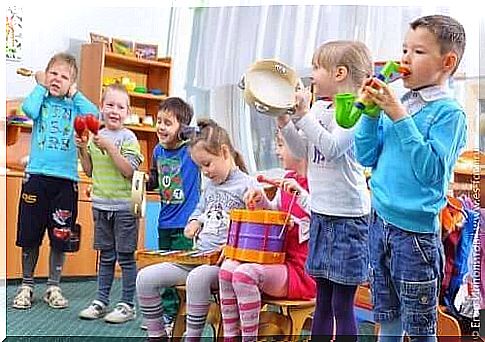Encouraging Cooperative Play In Children

Children’s collaborative play is a recreational activity that promotes teamwork. The intent is to achieve a common goal rather than focus on competition.
This didactic tool is great for teaching morals today. It is also an excellent way to promote strategies to develop social skills as adults.
Collaborative play with children
The concept of collaborative or collaborative play is intended as an alternative to competitive games with playful proposals, developed in a relaxed, friendly environment. All children can participate without exclusion or discrimination. This way they can all contribute to their unique skills.
As you can see, there are many benefits of cooperative play in children. In the short term, it contributes to a constructive educational environment. In addition, it improves positive social interaction skills in the long run.
Reasons to encourage collaborative play in children
1. It creates awareness, respect and solidarity

Empathy is one of the values practiced in collaborative play, its purpose is to promote awareness and respect for peers. First, a cooperative game is based on the principles of respect and solidarity.
The aim is therefore to create awareness in a playful way to combat discrimination. It can also be a strategy to prevent bullying.
Some schools are already using these kinds of techniques that invite children to empathize with their classmates. This way, they can put themselves in other people’s shoes and come up with their options for solving challenges together.
2. Collaborative play is about collaboration and teamwork
This kind of game integrates all participants and invites them to help each other. In fact, it’s essential to find a way to solve a game as a team. So in no case can a child win individually, as in many games, because they all have an external element in common.
As you can see, children learn to appreciate each other’s special skills and know when to use them. For example, if children are good at math but not at sports, they will not be excluded from the group because they cannot win a race. Instead, they will be in charge of another task related to it.
3. It improves communication skills

In order to play this kind of game, children need to communicate with each other. This allows them to refine their social skills. To solve the tests or challenges of a game, children need to establish good communication with their peers. So they practice how to express themselves and express their opinions.
At the same time, they all learn to listen to each other. This strategy aims to balance communication between children who rarely talk with children who talk constantly. So there are equal opportunities for everyone.
4. Children’s collaborative play teaches about conflict resolution
Through play, children do not know that they are learning to resolve conflicts. The first step is to learn to express the need to resolve a conflict. So they check the effectiveness of this strategy and then transport it to other situations in the classroom or during a break.
In the same way , they will then learn to use this skill in their family environment and their work environment as they mature into adulthood.
5. It inspires confidence

Playing collaboratively encourages confidence and self-esteem. Finally, the collaborative play concept strengthens each child ‘s self-esteem and confidence.
Through this activity , they learn to fulfill an essential function within a group to achieve a common goal. They may even discover talents they didn’t know they had after observing their peers.
Collaborative play is a great learning tool to bring into an educational environment. Children are like sponges because they absorb everything they see. So they will integrate all these values in a rather spontaneous and natural way.









